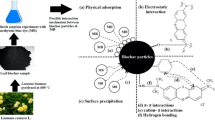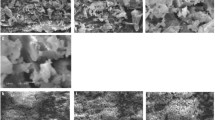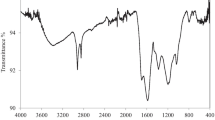Abstract
The practice of releasing highly noxious textile pollutants into the water environment is a matter of great distress to the living community. In view of this issue, the study was proposed on the removal of basic fuchsin red (BFR), methylene blue (MB), and crystal violet (CV) from its solution via adsorption using the biochar synthesized from areca leaf plate waste and turmeric leaf waste biomass through pyrolysis. A detailed study on the parameters influencing the adsorption such as adsorbent dosage (0.1–1 g), pH (3–10), temperature (35–50 °C), and initial dye concentration (10–200 mg/L) were carried out. From the batch study, the best removal efficiency for the removal of BFR dye for AB biochar was found to be 80.912% for 0.3 g adsorbent dosage, 8 pH, 35 °C, and 50 mg/L initial dye concentration; MB dye was obtained as 80.80% for 50 mg/L initial dye concentration; and CV dye was obtained as 80.60% for 50 mg/L initial dye concentration. For the TB biochar, the best removal efficiency for the removal of BFR dye was obtained as 87.44% for 0.2 g adsorbent dosage, 7 pH, 35 °C, and 50 mg/L initial dye concentration; MB dye was obtained as 83.20% for 50 mg/L initial dye concentration; and CV dye was obtained as 82.60% for 0.2 g adsorbent dosage, 7 pH, 35 °C, and 50 mg/L initial dye concentration. With the help of RSM, the concurrent interactive effects of various process variables on an output response were analysed. The Langmuir isotherm model was found to be a perfect fit with R2 value of 0.98 for both AB and TB biochar bounded on BFR dye and the pseudo-second order kinetics model was found to be a perfect fit for both AB and TB biochar bounded on basic fuchsin red dye. Additionally, the efficiency of the AB and TB biochar to desorb BFR, MB, and CV dye using various eluctants such as HCl, NaOH, and de-ionized water for four regeneration cycles were studied and the HCl eluctant was found to be highly efficient in the desorption of all three dyes after four regeneration cycles.



















Similar content being viewed by others
References
Jabar JM, Odusote YA (2021) Utilization of prepared activated biochar from water lily (Nymphaea lotus) stem for adsorption of malachite green dye from aqueous solution. Biomass Convers Biorefinery 1–12
Singh S, Prajapati AK, Chakraborty JP, Mondal MK (2021) Adsorption potential of biochar obtained from pyrolysis of raw and torrefied Acacia nilotica towards removal of methylene blue dye from synthetic wastewater. Biomass Convers Biorefinery 1–22
Bradbury S, Evennett P (2020) Contrast techniques in light microscopy. Garland Science
Kaya N, Uzun ZY (2021) Investigation of effectiveness of pine cone biochar activated with KOH for methyl orange adsorption and CO 2 capture. Biomass Convers Biorefinery 11:1067–1083
Saravanan P, Josephraj J, Thillainayagam BP, Ravindiran G (2021) Evaluation of the adsorptive removal of cationic dyes by greening biochar derived from agricultural bio-waste of rice husk. Biomass Convers Biorefinery 1–14
Ting ASY (2020) Actinobacteria for the effective removal of toxic dyes. Microorg Sustain Environ Heal 37
Zhao J, Wu Q-X, Cheng X-D et al (2021) Biodegradation and detoxification of the triphenylmethane dye coomassie brilliant blue by the extracellular enzymes from mycelia of Lactarius deliciosus. Front Chem Sci Eng 15:421–436
Neha R, Adithya S, Jayaraman RS, et al (2021) Nano-adsorbents an effective candidate for removal of toxic pharmaceutical compounds from aqueous environment: a critical review on emerging trends. Chemosphere 129852
Ngulube T, Gumbo JR, Masindi V, Maity A (2017) An update on synthetic dyes adsorption onto clay based minerals: a state-of-art review. J Environ Manage 191:35–57. https://doi.org/10.1016/j.jenvman.2016.12.031
Ahirrao S (2014) Zero liquid discharge solutions. In: Industrial wastewater treatment, recycling and reuse. Elsevier Inc., pp 489–520
Dada EO, Ojo IA, Alade AO, et al (2020) Biosorption of bromo-based dyes from wastewater using low-cost adsorbents: a review. J Sci Res Reports 34–56
Sardar M, Manna M, Maharana M, Sen S (2021) Remediation of dyes from industrial wastewater using low-cost adsorbents. In: Green adsorbents to remove metals, dyes and boron from polluted water. Springer, pp 377–403
Yagub MT, Sen TK, Afroze S, Ang HM (2014) Dye and its removal from aqueous solution by adsorption: a review. Adv Colloid Interface Sci 209:172–184. https://doi.org/10.1016/j.cis.2014.04.002
Bulgariu L, Escudero LB, Bello OS et al (2019) The utilization of leaf-based adsorbents for dyes removal: a review. J Mol Liq 276:728–747. https://doi.org/10.1016/j.molliq.2018.12.001
Allam NG, Ismail GA, Mohamed WME (2019) Biosynthesis of silver nanoparticles by cell-free extracts from some bacteria species for dye removal from wastewater. Biotechnol Lett 0123456789:https://doi.org/10.1007/s10529-019-02652-y
Kumar KV, Ramamurthi V, Sivanesan S (2006) Biosorption of malachite green , a cationic dye onto Pithophora sp ., a fresh water algae. 69:102–107. https://doi.org/10.1016/j.dyepig.2005.02.005
Nautiyal P, Subramanian KA, Dastidar MG (2016) Adsorptive removal of dye using biochar derived from residual algae after in-situ transesterification: alternate use of waste of biodiesel industry. J Environ Manage 182:187–197. https://doi.org/10.1016/j.jenvman.2016.07.063
El-sheekh MM, Gharieb MM, Abou-el-souod GW (2009) International biodeterioration & biodegradation biodegradation of dyes by some green algae and cyanobacteria. Int Biodeterior Biodegradation 63:699–704. https://doi.org/10.1016/j.ibiod.2009.04.010
Arun J, Gopinath KP, SundarRajan P, et al (2020) Hydrothermal liquefaction and pyrolysis of Amphiroa fragilissima biomass: comparative study on oxygen content and storage stability parameters of bio-oil. Bioresour Technol Reports 11:100465
Foong SY, Liew RK, Yang Y, et al (2020) Valorization of biomass waste to engineered activated biochar by microwave pyrolysis: progress, challenges, and future directions. Chem Eng J 389:124401
Abnisa F, Arami-Niya A, Wan Daud WMA et al (2013) Utilization of oil palm tree residues to produce bio-oil and bio-char via pyrolysis. Energy Convers Manag 76:1073–1082. https://doi.org/10.1016/j.enconman.2013.08.038
Ba Mohammed B, Hsini A, Abdellaoui Y et al (2020) Fe-ZSM-5 zeolite for efficient removal of basic fuchsin dye from aqueous solutions: synthesis, characterization and adsorption process optimization using BBD-RSM modeling. J Environ Chem Eng 8:104419. https://doi.org/10.1016/j.jece.2020.104419
Amin MT, Alazba AA, Shafiq M (2021) Successful application of eucalyptus camdulensis biochar in the batch adsorption of crystal violet and methylene blue dyes from aqueous solution. Sustain 13:https://doi.org/10.3390/su13073600
Bharti V, Vikrant K, Goswami M et al (2019) Biodegradation of methylene blue dye in a batch and continuous mode using biochar as packing media. Environ Res 171:356–364. https://doi.org/10.1016/j.envres.2019.01.051
Ahmad MA, Afandi NS, Adegoke KA, Bello OS (2016) Optimization and batch studies on adsorption of malachite green dye using rambutan seed activated carbon. Desalin Water Treat 57:21487–21511. https://doi.org/10.1080/19443994.2015.1119744
Singh RK, Pandey D, Patil T, Sawarkar AN (2020) Pyrolysis of banana leaves biomass: physico-chemical characterization, thermal decomposition behavior, kinetic and thermodynamic analyses. Bioresour Technol 310:123464
Kim JE, Bhatia SK, Song HJ, et al (2020) Adsorptive removal of tetracycline from aqueous solution by maple leaf-derived biochar. Bioresour Technol 306:123092
Ray A, Banerjee A, Dubey A (2020) Characterization of biochars from various agricultural by-products using FTIR spectroscopy, SEM focused with image processing. Int J Agric Environ Biotechnol 13:423–430
Choi YK, Gurav R, Kim HJ et al (2020) Evaluation for simultaneous removal of anionic and cationic dyes onto maple leaf-derived biochar using response surface methodology. Appl Sci 10:1–12. https://doi.org/10.3390/app10092982
Pattnaik D, Kumar S, Bhuyan SK, Mishra SC (2018) Effect of carbonization temperatures on biochar formation of bamboo leaves. In: IOP Conference Series: Materials Science and Engineering. IOP Publishing, p 12054
Ghysels S, Ronsse F, Dickinson D, Prins W (2019) Production and characterization of slow pyrolysis biochar from lignin-rich digested stillage from lignocellulosic ethanol production. Biomass Bioenerg 122:349–360. https://doi.org/10.1016/j.biombioe.2019.01.040
Yu S, Park J, Kim M et al (2019) Characterization of biochar and byproducts from slow pyrolysis of hinoki cypress. Bioresour Technol Reports 6:217–222. https://doi.org/10.1016/j.biteb.2019.03.009
Vieira FR, Romero Luna CM, Arce GLAF, Ávila I (2020) Optimization of slow pyrolysis process parameters using a fixed bed reactor for biochar yield from rice husk. Biomass Bioenerg 132:105412. https://doi.org/10.1016/j.biombioe.2019.105412
Yue Y, Lin Q, Xu Y et al (2017) Slow pyrolysis as a measure for rapidly treating cow manure and the biochar characteristics. J Anal Appl Pyrolysis 124:355–361. https://doi.org/10.1016/j.jaap.2017.01.008
Lee XJ, Lee LY, Hiew BYZ et al (2017) Multistage optimizations of slow pyrolysis synthesis of biochar from palm oil sludge for adsorption of lead. Bioresour Technol 245:944–953. https://doi.org/10.1016/j.biortech.2017.08.175
Ghysels S, Estrada Léon AE, Pala M et al (2019) Fast pyrolysis of mannan-rich ivory nut (Phytelephas aequatorialis) to valuable biorefinery products. Chem Eng J 373:446–457. https://doi.org/10.1016/j.cej.2019.05.042
Sotoudehniakarani F, Alayat A, McDonald AG (2019) Characterization and comparison of pyrolysis products from fast pyrolysis of commercial Chlorella vulgaris and cultivated microalgae. J Anal Appl Pyrolysis 139:258–273. https://doi.org/10.1016/j.jaap.2019.02.014
Karmee SK, Kumari G, Soni B (2020) Pilot scale oxidative fast pyrolysis of sawdust in a fluidized bed reactor: a biorefinery approach. Bioresour Technol 318:124071. https://doi.org/10.1016/j.biortech.2020.124071
Gautam R, Shyam S, Reddy BR et al (2019) Microwave-assisted pyrolysis and analytical fast pyrolysis of macroalgae: product analysis and effect of heating mechanism. Sustain Energy Fuels 3:3009–3020. https://doi.org/10.1039/C9SE00162J
Jegan J, Praveen S, Muthu Kumar B, Bhagavathi Pushpa T & Gokulan R (2021) Box–Behnken experimental design for the optimization of basic violet 03 dye removal by groundnut shell derived biochar, desalination and water treatment, vol. 209, pp. 379–391. doi.org/https://doi.org/10.5004/dwt.2021.26615
Jegan J, Praveen S, Bhagavathi Pushpa T, Gokulan R (2020) Biodecolorization of basic violet 03 using biochar derived from agricultural wastes: isotherm and kinetics. J Biobased Mater Bioenergy 14(03):316–326. https://doi.org/10.1166/jbmb.2020.196
Thillainayagam BP, Saravanan P, Ravindiran G et al (2021) Continuous sorption of methylene blue dye from aqueous solution using effective microorganisms-based water hyacinth waste compost in a packed column. Biomass Conv Bioref. https://doi.org/10.1007/s13399-020-01208-9
Saravanan P, Thillainayagam BP, Ravindiran G, Josephraj J (2020) Evaluation of the adsorption capacity of Cocos nucifera shell derived biochar for basic dyes sequestration from aqueous solution. Energy Sources, Part A Recov Util Environ Effects:1–17. https://doi.org/10.1080/15567036.2020.1800142
Pushpa T, Bhagavathi; Josephraj, Jegan; Saravanan, Praveen; Ravindran, Gokulan, (2019) Biodecolorization of basic blue 41 using EM based composts: isotherm and kinetics. ChemistrySelect 4(34):10006–10012. https://doi.org/10.1002/slct.201901774
Jegan J, Praveen S, Bhagavathi Pushpa T, Gokulan R (2020) Sorption kinetics and isotherm studies of cationic dyes using groundnut (Arachis hypogaea) shell derived biochar a low-cost adsorbent. Appl Ecol Environ Res 18(1):1925–1939. https://doi.org/10.15666/aeer/1801_19251939
Kumar M, Gokulan R, Sujatha S et al (2021) Biodecolorization of reactive red 120 in batch and packed bed column using biochar derived from Ulva reticulata. Biomass Conv Bioref.https://doi.org/10.1007/s13399-020-01268-x
Acknowledgements
The authors convey their sincere thanks to the Management and the Principal of Coimbatore Institute of Technology, Coimbatore, 641014, for the support given to carry out the research activity.
Author information
Authors and Affiliations
Corresponding author
Additional information
Publisher’s note
Springer Nature remains neutral with regard to jurisdictional claims in published maps and institutional affiliations.
Rights and permissions
About this article
Cite this article
Nithyalakshmi, B., Saraswathi, R. Removal of colorants from wastewater using biochar derived from leaf waste. Biomass Conv. Bioref. 13, 1311–1327 (2023). https://doi.org/10.1007/s13399-021-01776-4
Received:
Revised:
Accepted:
Published:
Issue Date:
DOI: https://doi.org/10.1007/s13399-021-01776-4




